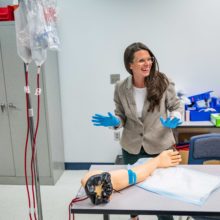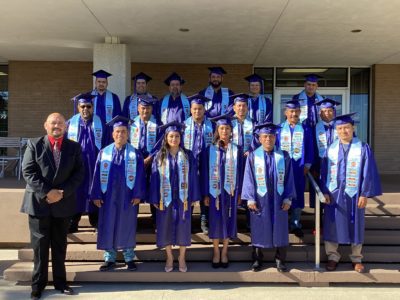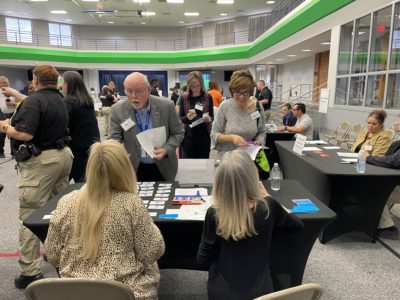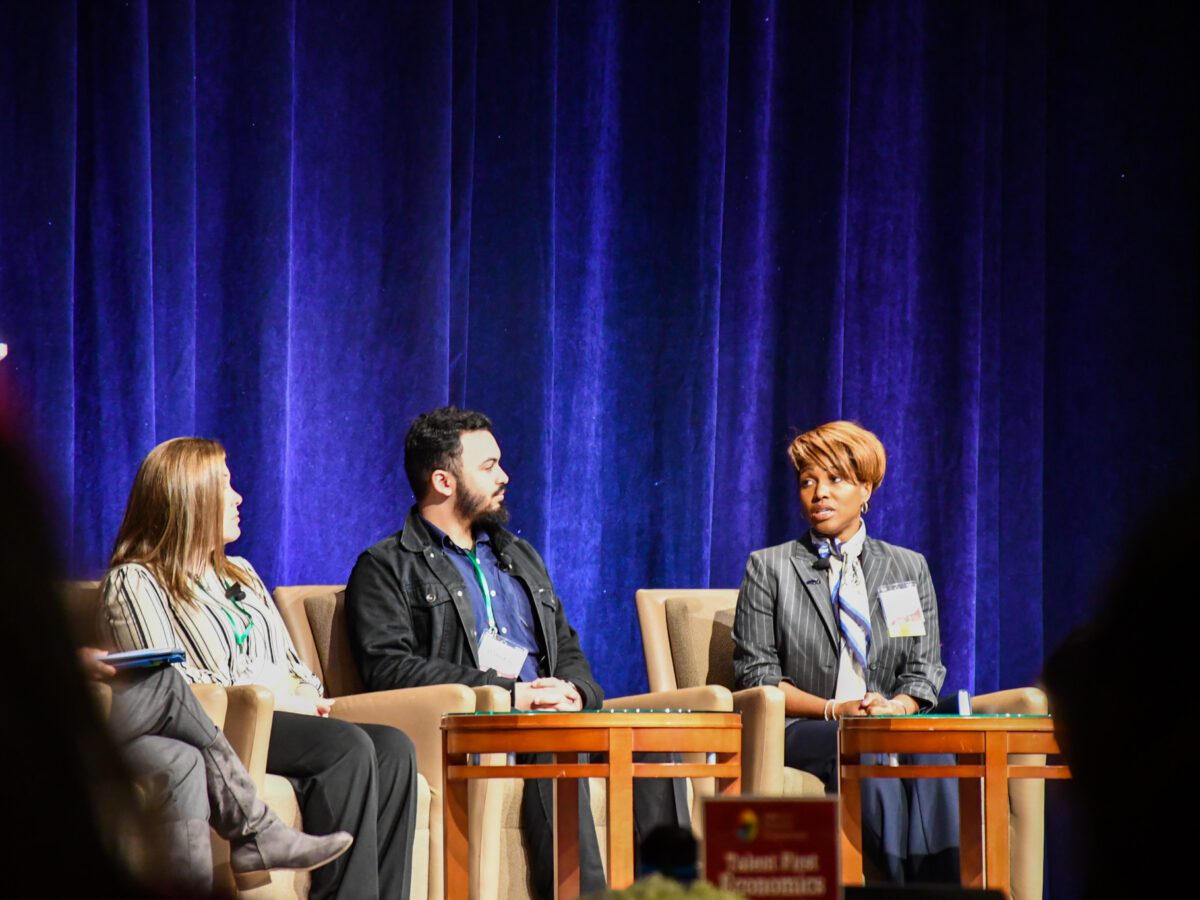
Share this story
- "We must acknowledge the transformation needed for a robust healthy workforce, so we can remain competitive in the future,” @emergingissues Director @sarahhallNC said.
- “As I recruit companies or as I check with them as to how they're doing in North Carolina, the three main concerns are workforce, workforce, and workforce,” @RoyCooperNC told @emergingissues attendees.
|
|
N.C. State University’s Institute for Emerging Issues (IEI) hosted their annual forum this week, spotlighting how the state can address the labor shortage and meaningfully engage workers. This year’s theme – Talent First Economics – centered on putting people at the forefront to connect more individuals to the workforce and grow the state’s talent pool.
The Institute for Emerging Issues forum has convened people from diverse sectors and geographic locations since 1986, leading to policy reforms and investments that continue to shape North Carolina.
“… This isn’t any ordinary convening. It’s an entire day dedicated to learning new perspectives. It’s a space to engage with others who can assist us in our workforce to shape ideas and solutions,” IEI Director Sarah Langer Hall said. “And it’s a chance for all of us to be a part of something bigger and more important than just ourselves or our individual work.”
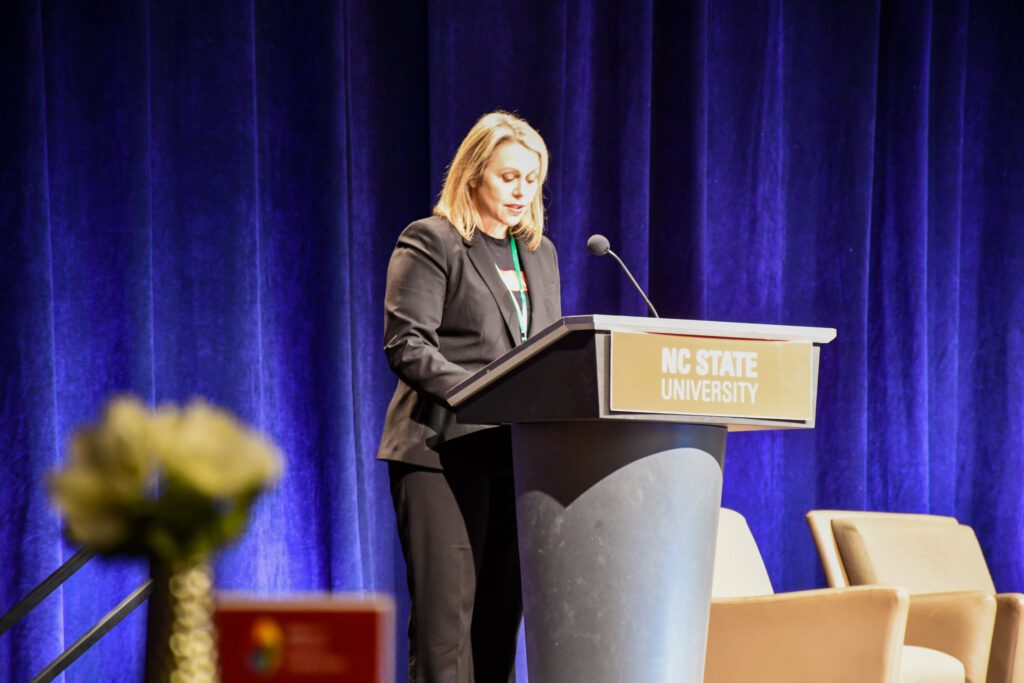
Talent first economics
Gov. Roy Cooper spoke about how North Carolina leaders are working to advance workforce development at the state level. Cooper shared the importance of reaching the state’s attainment goal in such efforts.
“As I recruit companies or as I check with them as to how they’re doing in North Carolina, the three main concerns are workforce, workforce, and workforce,” he said.
Cooper outlined other strategies to grow the state’s workforce — from bipartisan support for immigration reform to second chances for formerly incarcerated people and access for people with disabilities.
Cooper also stressed the importance of funding public education – across the spectrum.
“And our real strength, our communities, and colleges and universities – let’s remember that they are strong because of the foresight of so many people in this room and people who have come before us for decades,” he said, also praising the state’s four public HBCUs. “We have the best community college system in the country. We need to make sure we keep it that way, investing in our instructors and investing in students and making sure that they can get an education.”


A few weeks earlier, myFutureNC convened leaders to discuss the state’s attainment goal of ensuring 2 million North Carolinians ages 25-44 will have a high-quality credential or postsecondary degree by 2030. According to myFutureNC President and CEO Cecilia Holden, the state is still behind where it needs to be in order to meet the 2 million goal by 2030.
As the IEI task force draft report notes, the workforce supply issue is multilayered, ranging from declining birth rates, baby boomers retiring, and lack of child care options. At the same time, the state and country are experiencing incredible job growth.
“Economists were expecting about 180,000 new jobs to be added last month (January), and it was 517,000 jobs,” said Laura Dawson Ullrich, senior regional economics for the Federal Reserve Bank of Richmond.
So how can the state address the challenges ahead?
According to leaders of IEI, the solutions are multilayered. Many of the forum’s proposed solutions focus on connecting people to the workforce who have historically experienced barriers in doing so.
‘Connect the underrepresented’
The event included breakout sessions about serving five groups in particular to “connect the underrepresented.” The groups were: the justice-involved, transitioning military, opportunity youth, people with disabilities, and families with young children.
“It’s also important to note that these are not exclusive groups of workers,” Hall said. “In fact, there is a lot of intersectionality that we will consider in our connection spotlights, which will explore best practices for engaging older workers, bilingual and bicultural workers, as well as rural workers.”
Justice-involved
Formerly incarcerated people face many employment challenges, said Andrew Berger-Gross, a senior economist with the N.C. Department of Commerce. In 2020, just 48% of formerly incarcerated individuals were employed one year after their release, he said in his breakout presentation, compared to 61% of the overall population aged 16 and older.
And for the formerly incarcerated who are employed one year after release, median annual earnings were $7,500. For the general population, that number is $35,000. However, Berger-Gross said many of those people had lower wages before prison as well, citing the issues of lower work experience and educational attainment.
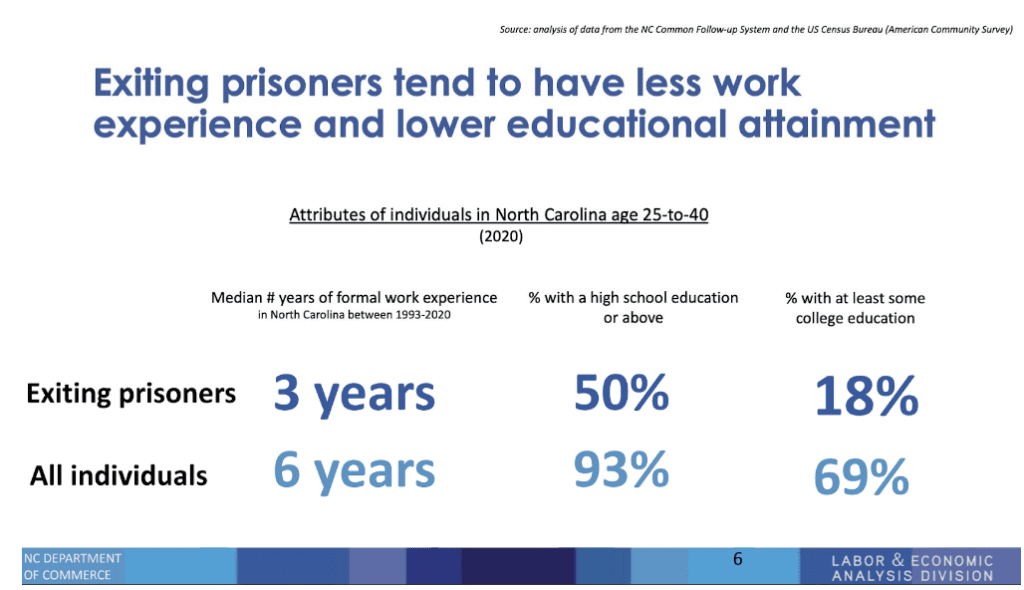
Helping with reentry efforts can reduce such barriers, he said, by providing former prisoners more work experience, skills, and education. Roughly 95% of those incarcerated in the state today will be released, but the reentry process is challenging. Studies show educational training and work release programs significantly reduce recidivism rates.
Philip Cooper, IEI’s practitioner in residence, spoke throughout the forum about the importance of second chances. Cooper, who was formerly incarcerated himself, also served on IEI’s task force on connecting people to the workforce.
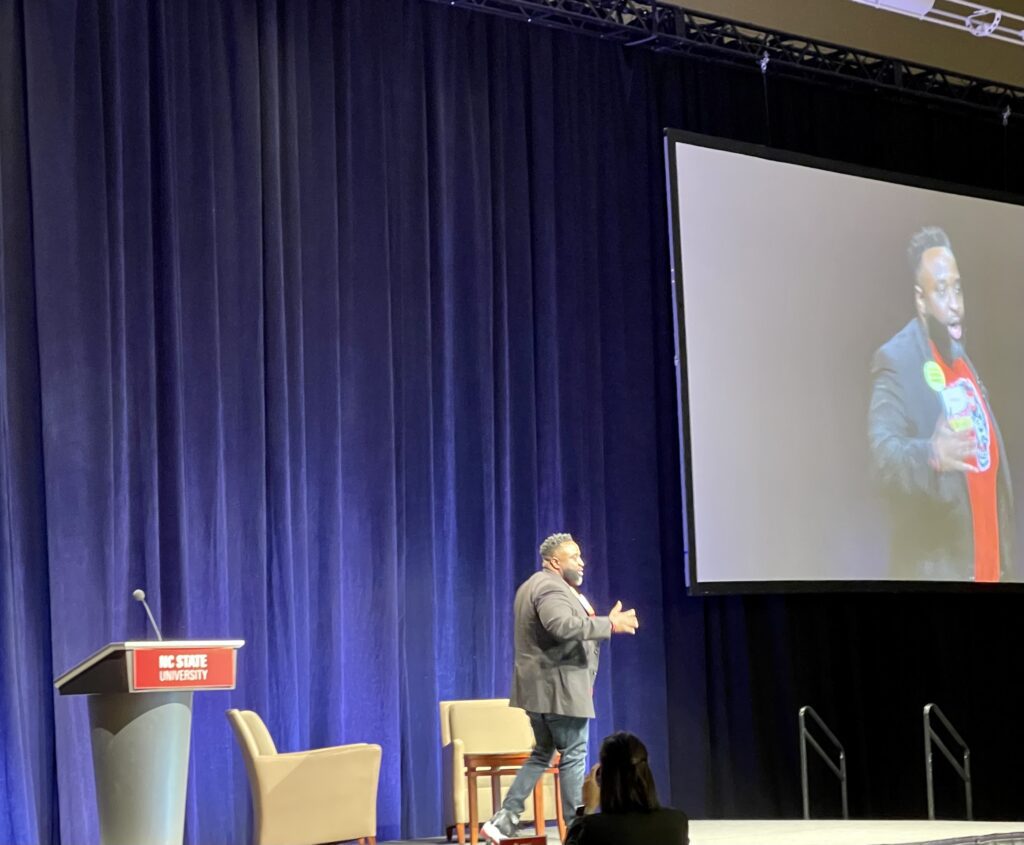
“When I was in prison, I didn’t have any other skills, but I knew I had to get a job when I got out. And I know a lot of people like that,” Cooper said. “I think about how important it is for a person to have meaningful work.”
Transitioning military
Among members of the military in North Carolina who are transitioning out of service, only about 40% plan to stay in the state, according to survey data from the breakout presentation. But retaining veterans adds more businesses, skills, taxpayers, and engaged residents to the state, panelists said.
The breakout panelists said that streamlining credentialing processes for veterans would make the state more appealing for many families, as well as consolidating information from the various resources available to ensure accuracy.
Veteran organizations also need to connect people to careers, not jobs, panelists said, in order to keep them in state
“Veterans, we’re not damaged,” one attendee said. “We’re here and we want to work and we want our employers to value us.”
As students, veterans are more likely to complete postsecondary programs than their non-veteran peers, but they tend to take longer to do so. Panelists said that easing the transition out of military life can help many veterans succeed in what comes next. In North Carolina, about 44% of veterans plan to work full-time, according to the breakout data, and 36% plan to attend college full-time.
Opportunity youth
Opportunity youth are individuals between the ages of 16-24 who are neither in school nor working full- or part-time. According to myFutureNC, more than 7% of youth in North Carolina were disconnected prior to the pandemic.
As of 2021, one in eight N.C. youths are now disconnected from school or work, said Jonathan Guarine, IEI breakout panelist and N.C. Department of Commerce economist. After large Covid-related increases, 2021 saw a quick rebound, he said.
Efforts to engage disconnected youth should focus on short-term workforce development, breakout panelists said. Additionally, community action and social capital are critical.
“I got a chance to come back to my own community and work and be a changemaker. So I am an opportunity youth,” said Randolph Keaton, executive director of Men and Women United for Youth and Families. “All of us have a similar story to tell, like there was somebody that helped us along the way. There is something to speak to when a person finds their purpose.”
Disability and neurodiversity
Panelists at the breakout discussion on disability and neurodiversity said everyone is proximate to the challenges that neurodivergent and individuals with disabilities face. Because of that, the discussion for creating opportunities in the workforce should be more persistent.
About 1.4 million North Carolinians have some type of disability – 13.5% of the state. But people with disabilities have much lower employment rates than those without disabilities. One-quarter of people with disabilities were employed in 2021, according to U.S. Census Bureau data, compared to 65% of those without disabilities. And students with disabilities are less likely to enroll in and complete higher education.
Employers and schools must counter stigmas to help disabled students and workers access necessary supports, panelists said. Employees should also move away from viewing disabilities as hindrances.
“North Carolina, we talk about, as an employment-first state. So that means that regardless of your abilities, your disabilities, you have a purpose,” said Beth Butler Fadel, executive director of Disability:IN North Carolina. “There is a place for everybody in America’s workforce – a place for everybody, regardless of a disability. This is 2023. We’ve been talking about these issues for a long time.”
Families with young children
For families with young children, the lack of access to quality, equitable, and affordable child care is a looming challenge for the workforce, panelists said.
About 11% of the state’s total workforce are workers with children ages 5 and younger. From 2019 to 2020, about 88,000 of these workers left the workforce.
The problem doesn’t just impact parents with young children, panelists said. The child care crisis costs the state an estimated $3.5 billion each year.
“A small silver lining of Covid is that it really exposed so much of the burdens families were already carrying,” said journalist and IEI panelist Katherine Goldstein. “And people with power are now taking notice because it is impacting our economy. People cannot work because they do not have access to safe and affordable child care.”
Spotlighting solutions
In addition to discussing specific groups, IEI identified several “cross-cutting themes” for providing better resources and support.
- Make resources more accessible and relevant.
- Create comprehensive career pathways that meet the needs of businesses and underrepresented groups.
- Invest in the workforce behind the workforce.
- Create new funding models that make it easier for service providers to meet the unique needs of underrepresented populations.
- Create opportunities for peer-to-peer learning among employers, workforce developers, and service providers.
- Co-locate trusted service providers with workforce services to more effectively influence the support providers to meet the needs of underrepresented individuals.
Attendees also heard various ways institutions, organizations, and employers are connecting underrepresented populations to meaningful employment.
Connecting older adults
People are living longer, which means they’ll need to find ways to financially support themselves for longer, said Mindy Feldbaum, vice president of workforce programs for the AARP Foundation.
“Although older workers are the fastest growing segment of the workforce, unfortunately, our systems and mindsets have not kept pace,” Feldbaum said, “even in a tight labor market.”
Twilla Chavis Allen, the Lumber River Council of Government’s aging program administrator, said her organization saw jobs staying vacant for six months or longer – an unfortunately frequent problem.
Allen, who also partners with the Senior Community Service Employment Program (SCSEP), said older adults want to work, are self-starters, and are eager to learn new skills.
Take panelist Med Leggette for example. Leggette, 76 years young, is a receptionist for the Lumber River Council of Government. Before connecting with SCSEP, Leggette was told he was too old to apply for some jobs.

As a receptionist, Leggette responds to 50-100 phone calls a day. Those calls often include mayors, county commissioners, and town clerks. In addition to providing customer service, Allen said Leggette also learned a brand new telephone system at the organization.
The takeaway?
“Don’t be afraid if someone doesn’t have exactly everything that you’re looking for,” Allen said.
And, from Leggette: “Well, a lot of people my age don’t want to work. But the ones my age that do want to work, we will be there 15 to 20 minutes before time and be willing to stay after day. You know, we just enjoy being out.”
Connecting bilingual & bicultural workers
Lenoir Community College’s Centro Educativo Latino is a program that offers around 70 Spanish-language workforce courses. In the last two years, the center has served close to 2,000 Hispanic students. About 14% of Lenoir Community College students are Hispanic.
Because the courses are offered entirely in Spanish, the college draws a lot of students from counties all across the state – 29 so far.
And to mitigate some of those travel barriers, the college has an informal understanding with a nearby hotel who offers a discounted rate to students traveling for weekend courses.
Panelist Roman Pacheco Avila, who works as an HVAC and electrical technician for Sears, said the program gave him opportunities for a better job for him and his family.
“I will try to express what I feel to be part of Lenoir Community College,” said Avila. “They gave me a lot of chances and gave me more opened doors to do what I do today.”
Connecting rural workers
“Rural workers make up 15% of the national workforce, but just 5% of tech employment,” said LeClair Boone, talent development manager for N.C. Tech Paths. “Rural communities represent an untapped pipeline of tech talent.”
In January 2022, nonprofit N.C. Tech Paths, alongside Wilkes Community College, launched a program to connect rural workers in Northwest North Carolina to good paying jobs in technology.
“Our vision is to establish Northwest North Carolina with Wilkes County as its epicenter as a nationally recognized hub for rural tech workers,” Boone said. “We want to build a roadmap for other rural communities in North Carolina and across the country to tap into the digital economy.”
N.C. Tech Paths works in tandem with Wilkes Community College to recruit students into the college’s program. Students have options that range from a 12-week boot camp to a two-year degree to a four-year degree through a 2+2 program. N.C. Tech Paths supports students with living stipends, laptops, and professional coaching as they pursue their credential.
The nonprofit has a 90% job placement rate, and most students are seeing over 70% growth in their earnings in a six month period, said Boone.
Panelists Dahntay Choate and Hope Shurba both took advantage of N.C. Tech Paths and now work with Lowe’s Companies as associate technology support technicians.
“When you go from making that 25 to 30,000/year salary to 47 to 52,000/year, that’s a big change,” Shurba said. “And definitely one I’m happy with.”
“Getting that salary jump… like Hope said at 47 to 52,000/year was insane for us,” Choate added. “It definitely increased so many things… Happiness, well-being, and, of course, salary.”
Nearly half of the students N.C. Tech Paths serves are female, Boone said, which is about double the technology industry average. About half of the students are people of color.
Looking forward
In her closing remarks, Hall reminded attendees to show up in their sectors as “change agents” and commit to transforming the workforce ecosystem – helping connect underrepresented workers to good jobs and keep them engaged.
Next year’s IEI forum will convene on Feb. 13, 2024 and focus on financial resilience.
Editor’s Note: EdNC’s Hannah McClellan moderated the panel about Lenoir Community College’s Centro Educativo Latino.



